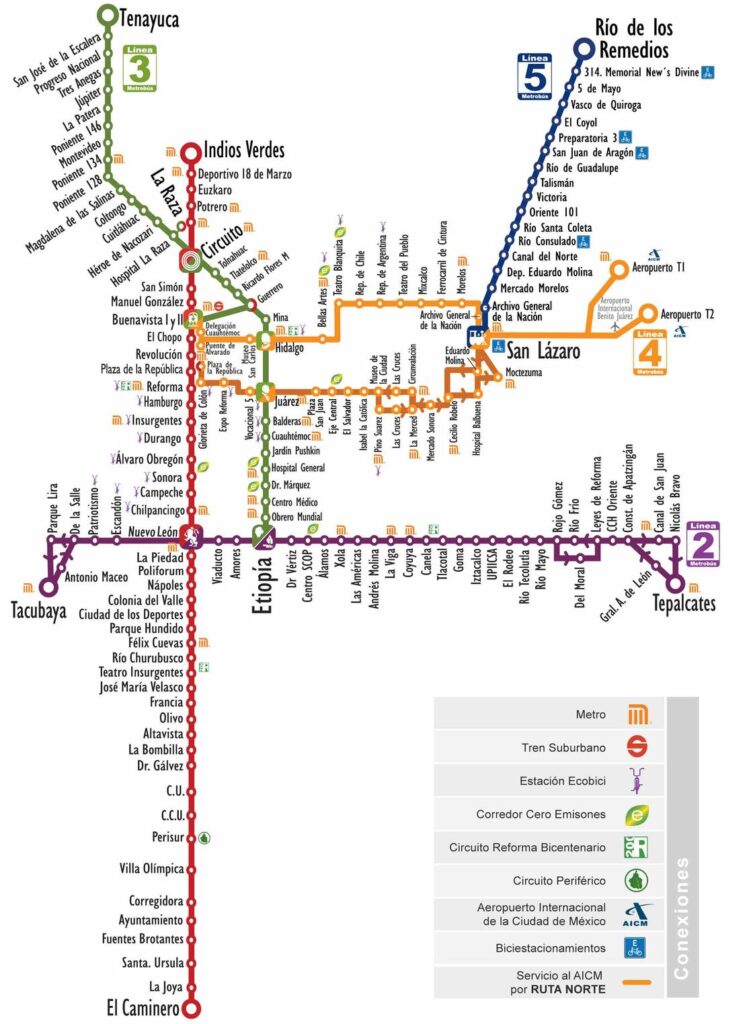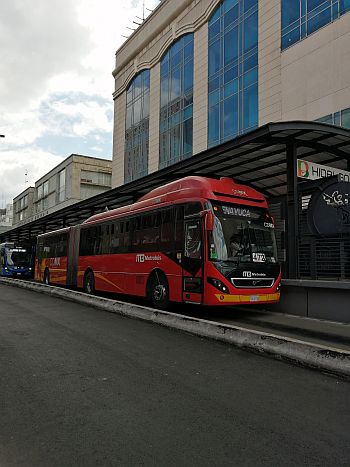
If you saw my earlier post on the Mexico City metro you will know I am not trying to explain routes here, more the Ins and Outs of riding public transportation which is always different in each city around the world.
Mexico City’s Metrobus is probably the most organized and used form of transportation in the city second only to the metro. It’s just as efficient as the regular metro and covers about as much territory with the metro stretching a tad further east than the Metrobus and the Metrobus a tad further south.
The Metrobus was created to be a more eco-friendly option than the regular buses. From what I have read they achieved this by running the buses in specific lanes, taking them out of stop-and-go traffic, using the most energy-efficient gasoline buses, and also, in some cases, using electric buses. They run along specific lines and all have identical stations, with a single entrance and exit so you avoid getting lost as I mentioned can be a problem with the regular metro.
Getting a Card/Getting a ride
The Metrobus is easy to use and only receives multimodal transportation cards as payment. These are available in most of the machines at the Metrobus stations for 15 pesos in addition to whatever you are putting on your card for credit. A one-way ride costs 6 pesos and you can get a transfer (which normally means leaving the station and walking a block or two to another), if you get on within 2 hours, one transfer per trip is allowed.
The trickiest thing about these stations is that often two lines are running on the same tracks for a series of stops and you may get confused and get on the wrong bus that seems to be going in your direction but actually has a different destination. This is usually no big deal if you are only going a stop or two, but if you are headed to the end of the line it can be a pain. Always make sure to check the direction and color of the line which shows up on a display on the top and side of the bus when it pulls in the station.
I find that the busiest hours for the Metrobus are mid-day but other riders have disagreed with me in the past. It’s a good idea to always expect a bunch of people and be pleasantly surprised when you have the bus to yourself. There are women-only cars here that are available as well as in the metro to avoid any handiness from men during rush hour. People seem to push and shove less on the Metrobus, assuming, I think, that the next bus will be along quickly so why bother.
There are police officers at almost every station near the turnstiles if you have questions or get lost.
Mexico City regular buses
If you use Google maps and choose the public transportation option for getting from place to place in Mexico City there will always be an option with regular buses. Some are regular city buses (usually pink or purple) and they run on pretty regular schedules without much fuss.
The others, micro-buses or peseros, are a little more unwieldy as they are generally private companies with drivers that run different routes all over the city and the suburbs. All are perfectly safe, and all will be packed during peak hours (especially mornings before the workday and afternoon/evenings when work ends).
The bus drivers tend to keep piling people into the bus until everyone’s like a little sardine because they want as many fares as possible. It’s possible to get on a bus that is waiting at a bus stop in a high-traffic area (like the Polanco metro station, for instance) and sit for 10 minutes while they wait for more customers to come and fill up the other seats and standing area. During peak after-work hours, people are likely to be hanging off of specific buses with high-traffic routes. Regular city buses charge 6 pesos for 5 kilometers or less and 7 for longer distances. To get off you push the red button, usually only one, near the back of the bus next to the back door and leave through the back door.
For what is generally called peseros, which is a minibus, you pay when you get on and you will need to have the correct change in hand. You pay the driver. The charge is either five pesos for 5 kilometers or less, or 5.50 or 6.50 for over 5 kilometers. They are supposed to have published rates listed somewhere on the bus. To get off you push the red or black button, usually only one, near the back of the bus next to the back door and leave through the back door.
For microbuses or vans, often the driver sits up front and opens the sliding van door with a kind of rope/trigger contraption (it’s amazing), letting you on without taking their hands from the wheel. In these microbuses you sit first and then pass your money up to the driver through various other passengers, calling out which stop you want to get off at as the fee is different depending on the length you are going (again, rates are supposed to be published).
Rides are generally no more than 10 pesos and no less than 5 (unless you are headed out to the suburbs as some of these buses go to the Estado de Mexico, the state next to the city). To get off you need to know where your stop is. The driver will stop there if he knows someone is getting off, but he doesn’t call it out except on occasion. If you need someone to tell you where to get off, you need to ask the driver that when you get on.

Last but not least is the Trolebus. This is a system of 9 lines on electric buses. You will be able to see they are connected to electrical lines from their rooftops. These buses function much in the same way as the Metrobus, except they are cheaper (3 pesos) and you cannot buy individual tickets but must have a multimodal transportation card.
Some basic vocabulary:
Voy a [station/location name] (I’m going to…) – said to the bus driver when you need to tell him your destination so he can calculate your fare (so microbuses and peseros)
¿Me dices cuando tengo que bajar? (Can you tell me when I need to get off) — said to the bus driver
¿Cuánto es? (How much?)
¿Vas al [station/location name]? (Are you going to…?) – said to the bus driver before you get on the bus
Permiso (Excuse me)
¿Vas a bajar? (You are getting off?) – Now this is a phrase that needs a little more context….
In Mexico, on any kind of public transportation where people are packed in and standing and someone needs to get off at the next stop, they will tap the person in front of them on the shoulder and say “Vas a bajar?” if you say no, they will immediately try to squeeze themselves in front of you to be closer to the exit and etiquette says that you should assist them by trying to get out of the way.
If you are also getting off at the next stop and so say yes, they will nod and leave you alone, assuming that you will do the fighting for both of you in order to get out the door.
Still nervous about taking public transportation in Mexico City? You can come along with me on my Mexico City 101 tour where we ride the metro (and Metrobus), see some of my favorite sites, learn street food etiquette, talk taxis and tips, and do a bunch of other things to get you ready for your time in Mexico City. Check out my tours page for more info or shoot me an email.
Click here to subscribe via RSS



